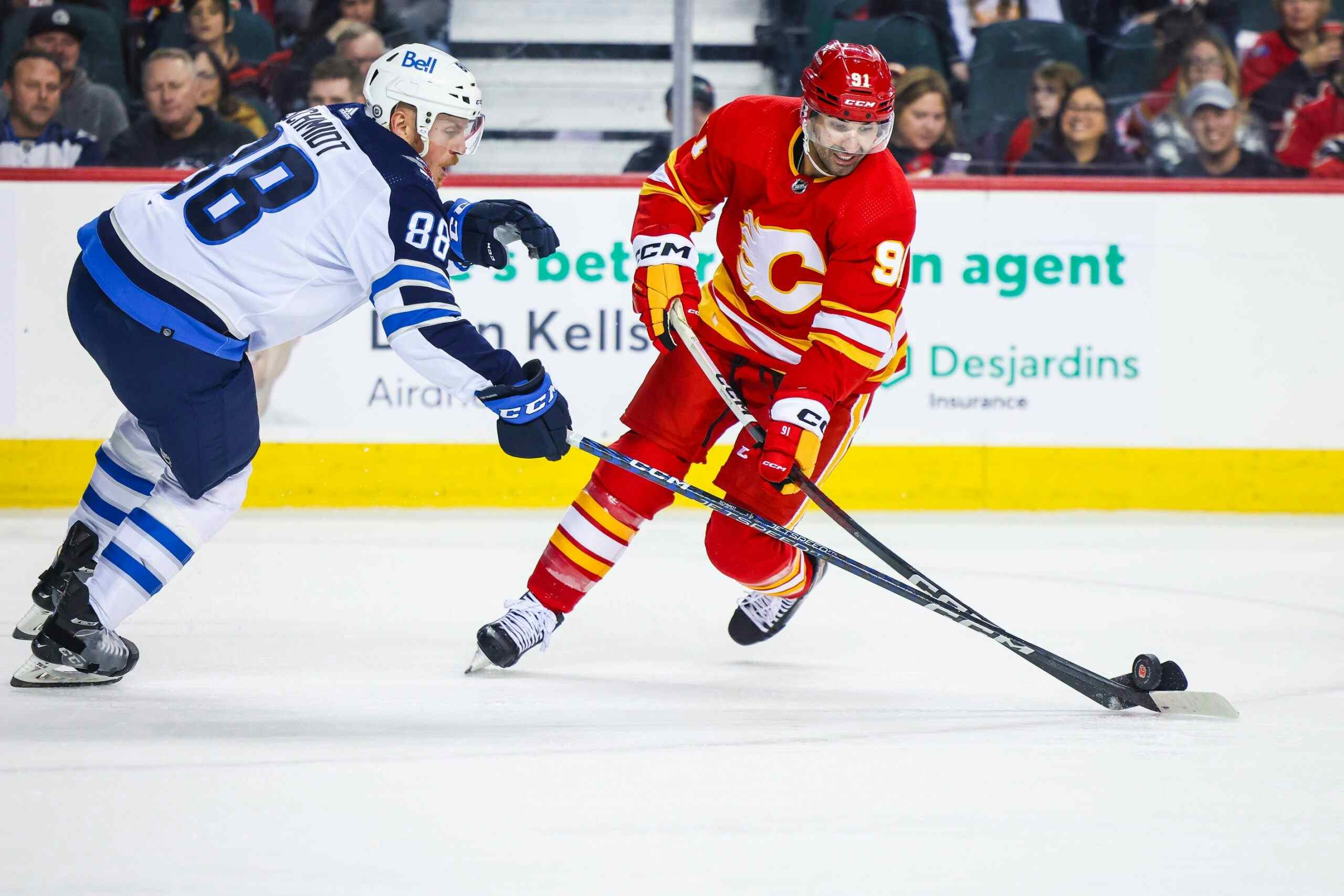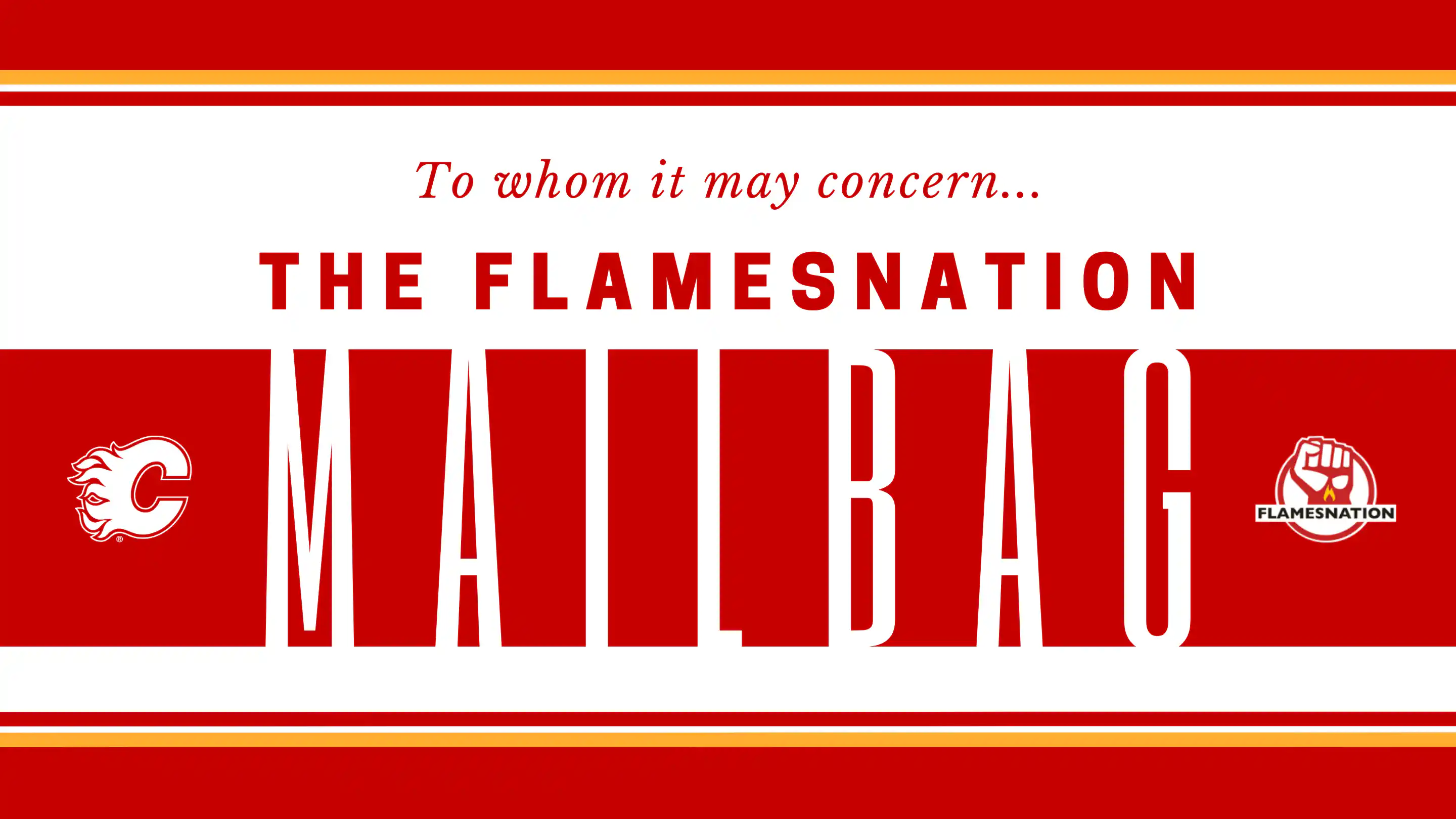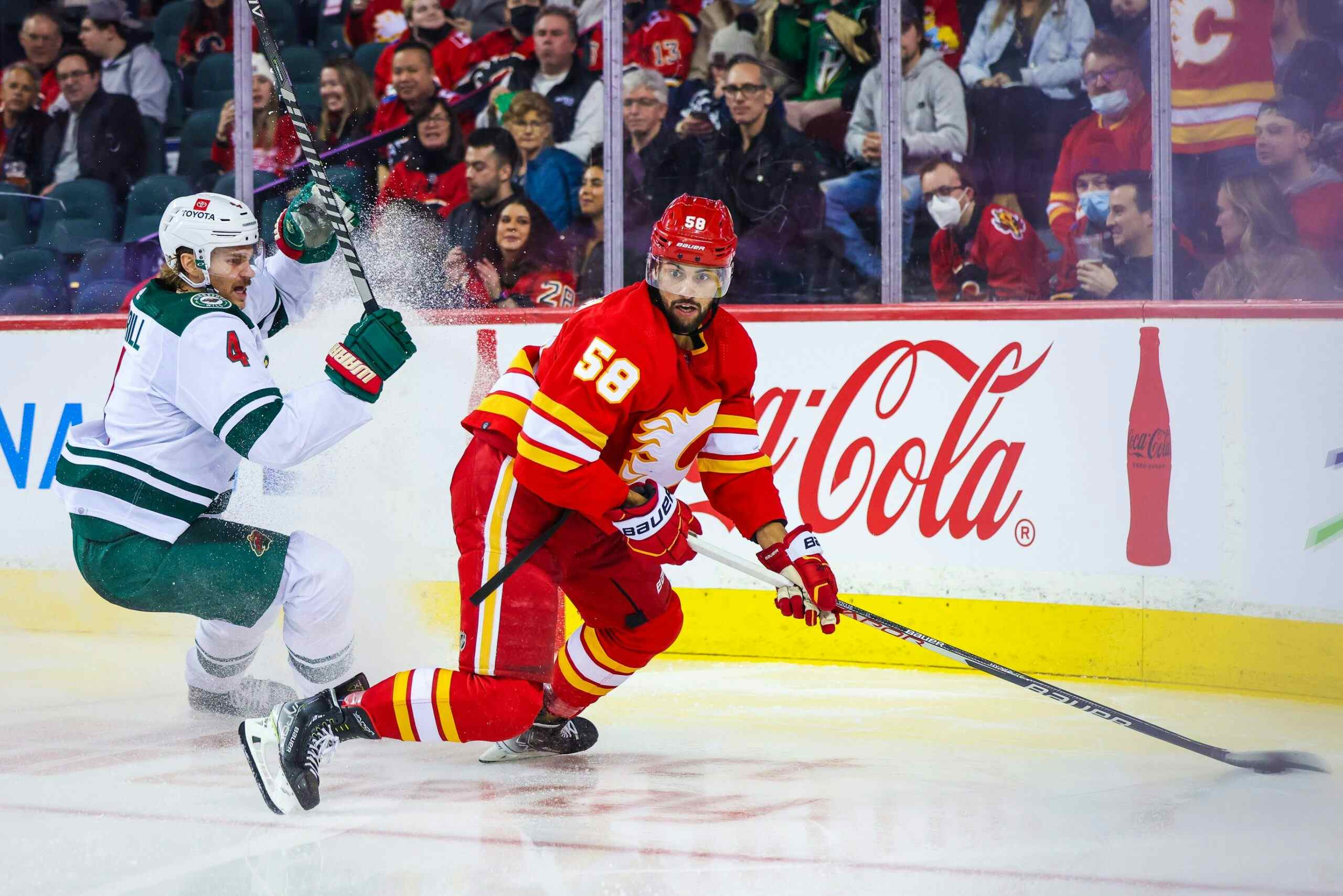Flames 3, Devils 2 post-game embers: Top four defenceman Dougie Hamilton
By Ari Yanover
8 years ago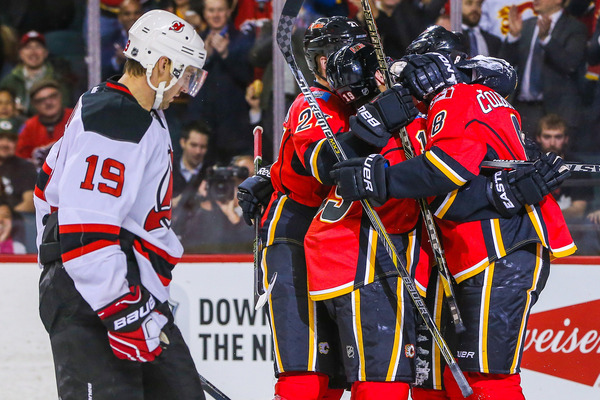
Photo Credit: Sergei Belski/USA TODAY Sports
The Calgary Flames, more or less, played a complete game. They scored early. They maintained their lead. They rolled their lines, they made sensible deployments.
Sure, special teams still need some work. Despite four powerplay opportunities, no goals were scored; they gave up a goal on one of three penalty kills (to Jordin Tootoo, who is apparently a powerplay guy now). But for the most part, you have to be happy with how the Flames played.
They won, and they looked composed while doing so.
Jonjan, or Stones?
We have a problem here: what do we call the excellent pairing that has been David Jones and Matt Stajan?
I could go with either. I like Jonjan because it’s fun to say, and reminds me of another silly nickname in JoJoo. But Stones is an actual word, plus you could interpret it for being “ballsy” or whatever.
Either way, the point is: I’m talking about this because Jones and Stajan have formed an extremely cohesive unit on the ice, and one that is honestly a delight to see game in and game out. Neither is a flashy player in the slightest, so they’re almost never going to get the glory. That said, they’re competent players. You stick them out there, and they know just what to do, and won’t make a mess of things.
While they were two of just six Flames to be negative possession players on the night, they were also both two-point players. Stajan scored his first of the season while Jones got the 100th goal of his career; Stajan’s created off the rush he initiated, and Jones’ the result of Stajan forcing a turnover, with both goal scorers right in front of the net at the right time.
They’re smart, capable veterans perfect for a bottom six role. I remember a time when I wanted neither on the team. I love having them both now, though, and I love watching them play together.
What’s up with Jiri Hudler?
Jiri Hudler’s usage appears to be going down – as it should be, because he has not been the player he was last season.
While Hudler’s normal linemates, Sean Monahan and Johnny Gaudreau, played 19:04 and 18:50 respectively on the night, Hudler played just 14:37. There isn’t much of a special teams disparity to account for there, either; Hudler got a solid 3:30 on the powerplay, only 44 fewer seconds than Johnny Gaudreau’s 4:14. And while Monahan played 3:37 with the extra man, he had 1:30 of penalty kill time. That really only accounts for a minute or so Hudler wasn’t there for, when we’re talking about a difference of four, four and a half minutes he was missing.
The entire second line, as well as Stajan and Jones, all received more ice time than he did; and rightfully so, as they all did more with it than him. Hudler registered one individual corsi event for, while the aforementioned five players generated at least one scoring chance apiece (and, in Sam Bennett’s case, four).
And then there’s Michael Frolik in particular, who took his spot for roughly two minutes of even strength ice time. Throughout the third period, the two alternated linemates.
When it was crunch time with a minute and a half to go and a one-goal lead to defend, it wasn’t Hudler out there alongside Monahan and Gaudreau, it was Frolik. And that line – along with the top pairing defensive unit of T.J. Brodie and Mark Giordano – kept the Devils from doing anything dangerous.
That said, Hudler actually did have a rather good ES CF% at 63.64%, second only to Deryk Engelland (who likes Deryk Engelland with limited minutes? I like Deryk Engelland with limited minutes!). But this isn’t the first time his ice time has started to fall this season. It’ll be interesting to see where we go from here, especially considering his potential to be trade bait.
Let’s talk zone entries
All three Flames goals came shortly after entering the offensive zone.
First, there was Gaudreau on Brodie’s goal:

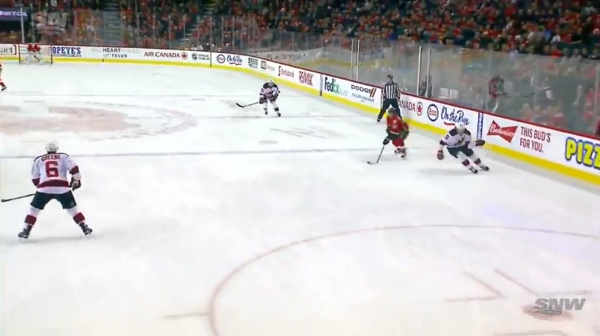
He could have avoided Adam Larsson outright by simply dumping the puck in. Instead, he was able to deke him out and carry the puck in himself, allowing the Flames to cycle it before they were able to get it to a wide open Brodie who did the rest. None of that happens without Gaudreau maintaining possession of the puck and getting things going the way he wanted them to go.
Then, there was Stajan’s dump in on his own goal:
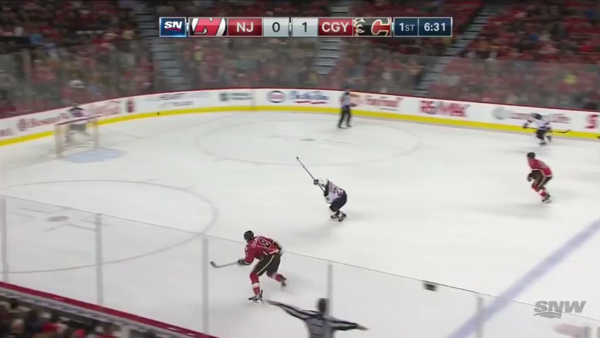
Stajan had all the space in the world to get that puck in. Colborne turned on the jets and retrieved the puck first, allowing the Flames to continue the play. Throwing it out front of the net where a bunch of Devils suddenly had to converge created a bit of chaos, allowing Stajan to come in and finish off the job by potting it in the back of the net.
And Jones’ goal, where things didn’t go as smoothly on the entry:
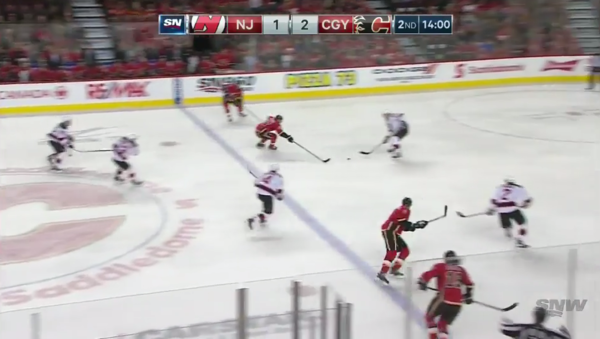
Stajan was unable to handle Brodie’s stretch pass, resulting in a turnover to the Devils. He redeemed himself by forcing a turnover of their own, which ultimately resulted in Jones’ goal, but compared to the previous two entries – Gaudreau carrying the puck in himself, and Colborne being fast enough to collect a puck that had no obvious opposing recipient – the outcome could have been worse.
T.J. Brodie’s skating is unreal
… How?
He danced around Lee Stempniak to get the opening goal of the game; he had that shift in the third where he generated a scoring chance just by going past everybody else, leaving them with nary a hope at catching him. Any time you see a potential two-on-one forming your worry instantly evaporates when you see it’s Brodie back on the play.
He’s almost impossible to get by, but he can sure get by opposing players. This is what’s seeing him become the Flames’ number one defenceman, capable of playing in all situations at huge minutes: because he seems to move about the ice effortlessly, on a completely different level from other players.
You can’t play hockey if you can’t skate. T.J. Brodie can skate exceptionally well, so he can play. A lot.
And finally, Dougie
Is this it? Has Dougie Hamilton’s time as a top four defenceman officially returned?
He’s been flirting with it for a while now. Despite technically being on a top four pairing with Kris Russell, he hasn’t been in the top four in minutes, with Dennis Wideman always leapfrogging him: sometimes with special teams, sometimes by simply taking over Hamilton’s partner.
Except throughout most of this game, Hamilton was actually leading his team in ice time. He finished with 22:43, which was fourth on the Flames, but we’re talking about a grand total of 16 seconds separating him from Mark Giordano, who had the most ice time. The top four defencemen were used evenly throughout, and finally, Hamilton was one of them.
Part of that was thanks to powerplay time. While Russell initially started the game on the powerplay, he was soundly booted off as the game went on. Hamilton led the way with 4:29 on the man advantage, and he looked pretty good out there with it. He helped gain the zone; he was taking shots. The Flames may not have scored on the powerplay, but Hamilton brought a new threat to the proceedings.
At 41.67%, he had the worst zone starts out of all Flames defencemen at even strength, so it doesn’t really come as a surprise to see that he was another of the six Flames who failed to be positive possession players. That said, he mostly saw the Devils’ Travis Zajac, Kyle Palmieri, and Sergey Kalinin out there: three of the Devils’ best possession players on the night. And indeed, when they weren’t facing Hamilton, Palmieri and Kalinin were north of 60% ES CF, while Zajac was at about 58%.
When those three Devils were on the ice against Hamilton, they ranged from 29.41-36.84%.
Let’s keep this rolling. It took about a quarter of the season, but if this is the Hamilton we’re getting for the next six years, well, the Flames’ backend will be in pretty decent shape.
Recent articles from Ari Yanover

